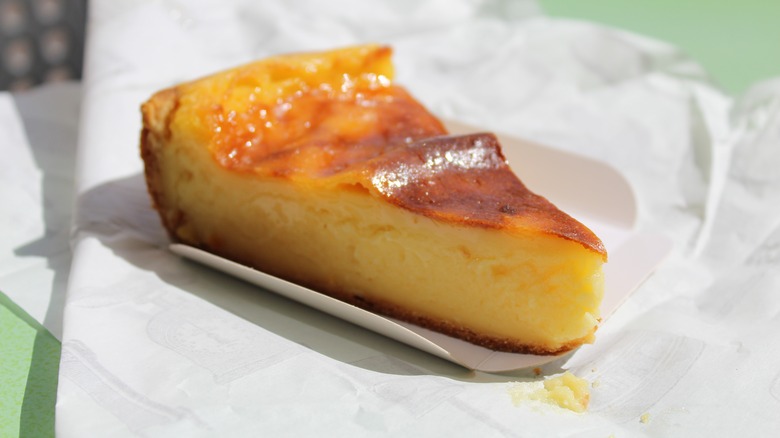Neapolitan Pizza's Origins As A Dessert Pie
When you hear "Neapolitan pizza," you likely think of warm tomato sauce, a crispy but simultaneously chewy crust, and a smattering of cheese to top it all off. You probably don't think about dessert, but as it turns out, the history of the name is a lot sweeter than expected. Although we know it as a cheesy slice, the iconic pizza was more well-known as a dessert pie with origins in Florence.
"Pizza alla Napoletana" — aka Neapolitan pizza — first appeared in a cookbook over 400 years ago in 1570. The crust — made of flour, sugar, butter, eggs, and lard — is filled with an almond-based custard filling, almost like the inside of a flan or crème brûlée. One author of a subsequent recipe that appeared in 1891, a man named Pellegrino Artusi, gives the baker the option of including either a note of citrus through lemon, or vanilla through its extract. Baking the dessert pizza can be a choose-your-own-adventure. The final product looks very similar to an Italian ricotta pie and is dusted with powdered sugar.
How did dessert pizza come to be?
The word "pizza" as we know it wasn't commonly used to describe the crust, tomato, and cheese combination until the early twentieth century. In Italian, it was more of a broad term to describe flat, baked, and flour-based dishes. Cheese pizza has origins as a street food and was actually more popular among the lower class as it was so cheap. The upper classes often expressed their distaste for it because it was eaten by the poor.
Pizza also had plenty of haters simply because it originated from the city of Naples. During the mid-1800s, Naples was teeming with trade and overcrowded, meaning that diseases like cholera could spread very quickly. Other Italians didn't like the city for its reputation, and pizza got lumped in with the general aversion. While the dessert custard may have been the initial standard, by the mid-1800s, there were a myriad of options available using cheap, local ingredients: tomatoes (thanks to the colonization of the Americas) and basil, plain garlic with lard, a horse-milk cheese, or even small fish like anchovies and sardines.
And yet, besides the fact that they have the same name, there is no connection between the sweet dessert pie and the Neapolitan pizza we've come to know and love today. The main thing the two have in common? The use of locally sourced ingredients.
So what about the modern version?
In Italy, a traditional Neapolitan pizza has a chewy and almost scorched crust due to the baking methods. The ovens these pizzas are subjected to can be around 900 degrees Fahrenheit, so even though the pie only goes in for about a minute and a half, the heat makes its mark. For Neapolitan pizza makers, the dough is the star of the show. One Los Angeles-based chef and owner of a Neapolitan pizzeria told Smithsonian Magazine, "Everything is about the dough." Said dough is made simply with only water, salt, yeast, and wheat flour. Some chefs may let their dough proof for days before commissioning it for pizza-making duties.
Because the dough is key, the toppings for Neapolitan are usually simple — you're probably used to seeing them topped simply with tomato sauce, mozzarella slices, and a garnish of basil leaves. The pizza and all of its topping variations are now eaten and loved around the world, not just as a street food in Naples. But, there are sticklers who would say that only Neapolitan pizza created according to the newly traditional methods and ingredients is real pizza — the original custard pie with the same name ultimately won't make the cut.



